Items
Site
The Medicine Chest
keywords is exactly
disciplines
-
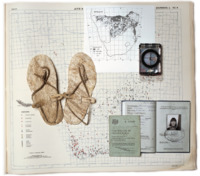
Page 175 of the Curiosity CLXXV catalogue
"The page presents a curated collection of images: a map from the Avian Demography Unit illustrating the distribution of the bataleur Terathopius ecaudatus along the political border, though the bateleur is more frequently found where there is no formal farming; a Ngwato child’s oxhide sandals collected by Isaac Schapera (a British social anthropologist who worked in South Africa and Botswana); a compass; the identification documents of Paula Ensor (previous dean and Professor of Education), who spent time in exile in Botswana; and a Certificate of Registration necessary for movement across borders, all of which are overlaid on top of a large map from the Afrikaans Atlas provided by Rajend Mesthrie of the Department of Linguistics and Southern African Languages that shows the Afrikaans language’s distribution. Contextualising all of these objects in relation to the large map cuts across disciplinary boundaries and illustrates the scope and impact of the colonial and apartheid regimes and their influence on immigration laws, language studies, ornithology and anthropology" (Liebenberg 2021: 193). -
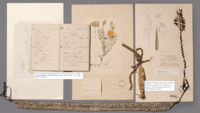
Pages 38-39 of the Curiosity CLXXV catalogue
"Objects and collections can reflect naturalisations that occur when the disciplinary perspective renders its subject matter in terms of what it deems worth looking at and how it should be looked at (Daston & Galison 2007: 23). This process has dual consequences, resulting in the honing of a specialised insider focus directed at the object and a blindness to qualities that sit outside the disciplinary frame of reference (as discussed in relation to the Drennan and Kirby collections). 'Curiosity CLXXV' drew on and challenged both these aspects by forcing objects into visual conversations outside their discipline and inviting insiders to view them in these new configurations. These curatorial strategies enabled insiders to become aware of characteristics not normally deemed important in their discipline and to identify the characteristics their discipline did deem important (their attentional subculture, in other words) in objects not studied in their field" (Liebenberg 2021: 180). -

Similitude
"In 'Similitude', Langerman brought together a selection of objects from three disparate disciplines – glassware from chemical engineering; a skull with an arrow embedded in it and a torch used as a murder weapon from forensic pathology; and two flutes from the Kirby collection. Ignoring the assigned functions the objects performed within their respective disciplines, she chose instead to use their formal characteristics as a taxonomic device. They were all, as she described them, ‘long thin things’ (Langerman n.d.). In displacing these objects from their respective disciplines and positioning them in proximity to objects that shared this new category, she neutralised their disciplinary functions and flattened their meanings within those fields (Langerman n.d.)" (Liebenberg 2021: 183). -

BC666
A page of the Tabloid guide. -

Curiosity CLXXV
Hiddingh Hall during the construction of the installation of Curiosity CLXXV. -

Hiddingh Hall
Hiddingh Hall prior to the installation of Curiosity CLXXV. -

'How Zoology was taught in the past'
The wall text accompanying these charts in the Hunterian museum, Glasgow, reads: "In the late 19th and 20th centuries, before the advent of colour slides that could be projected, the teaching of Zoology depended heavily on the use of wall charts to illustrate lectures. They were hung on a special pulley system at the front of the lecture theatre and, because of their large size, could be clearly seen from the back of the class". -

The Hunting of the Snark
"The Hunting of the Snark offers a timely caution for geographical investigation. The danger, both academic and pragmatic, of enslavement to static conceptual categories, rigid classifications, and established methodological procedures is simply that they tend to rule out the possibility of experiencing that insight and understanding which can be neither discovered, formulated nor communicated by adherence to traditional investigative methdologies. This is not to advocate an un-methodical and irrational geographical philosophy, but rather to suggest that there may be conditions under which slavish adherence to a tried and tested methodology may fail to provide reliable guidance in our search for understanding. A lack of commitment to open-ended investigation could mean that, because our methods are inappropriate, our explorations will forever remain, so to speak, 'snarked' ". -

Ocean Chart
"He had bought a large map representing the sea, Without the least vestige of land: And the crew were much pleased when they found it to be A map they could all understand". -

Kuhn's Jellyfish
Kuhn's "example illustrates how the entrenched expectations of experimental outcomes and prescribed instrumental functions of an insider’s view of the laboratory and its equipment can pose a threat to new discoveries. The circumstances that enabled Roentgen (an insider) to first notice these new rays are not clear, but Kuhn proposes that the occurrence of anomaly enables discovery and that Roentgen’s ‘recognition that nature has somehow violated the paradigm-induced expectations that govern normal science’ (1970: 52–3) was important. Kuhn emphasises that Roentgen valued the anomaly instead of ignoring it – a vital step in the process of discovery" (Liebenberg 2021: 114). -

175 chalk-board dusters
For the exhibition, 'Curiosity CLXXV', the curators took an old duster from each teaching venue and replaced it with a new one. -
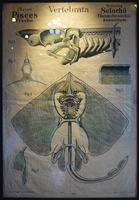
Scientific atlases
"Used from the 18th to the 20th centuries, the scientific atlases provided, for example, simplified, generalised and idealised versions of the objects of anatomy, physiology, botany, palaeontology and astronomy, to name a few, guiding the student and practitioner to what was worth looking at, how it looked and, perhaps most important of all, how it should be looked at (Daston & Galison 2007:23). The establishment and representations of these working sets of objects, and the standardised procedures for studying them, thus extended the initial influence exercised on the individual traveller in the field. By controlling the very act of seeing and by creating a sense of individuals working as members of academic communities, the atlases shaped the subjects and the objects of their disciplines. Processes initiated in the field and reinforced in institutions, societies and museums laid the foundation for procedures still used by the disciplinary insiders of university departments today" (Liebenberg 2021: 111). -

Looking up
In 'Looking up', the artist stares intently at the sky until he has attracted a group of curious bystanders to do the same (at which point he retires from the scene). -
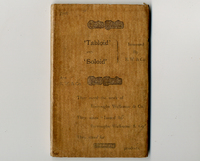
'Tabloid' A Brief Medical Guide (Back cover)
A guide to illnesses common to tropical regions and how to cure them using Burroughs Wellcome & Co.'s products -

'Tabloid' A Brief Medical Guide (End pages)
A guide to illnesses common to tropical regions and how to cure them using Burroughs Wellcome & Co.'s products -

'Tabloid' A Brief Medical Guide (p148)
A guide to illnesses common to tropical regions and how to cure them using Burroughs Wellcome & Co.'s products -

'Tabloid' A Brief Medical Guide (p146,147)
A guide to illnesses common to tropical regions and how to cure them using Burroughs Wellcome & Co.'s products -
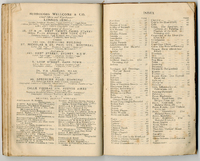
'Tabloid' A Brief Medical Guide (p144,145)
A guide to illnesses common to tropical regions and how to cure them using Burroughs Wellcome & Co.'s products -
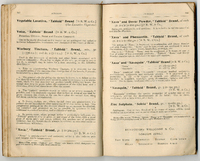
'Tabloid' A Brief Medical Guide (p142,143)
A guide to illnesses common to tropical regions and how to cure them using Burroughs Wellcome & Co.'s products -

'Tabloid' A Brief Medical Guide (p140,141)
A guide to illnesses common to tropical regions and how to cure them using Burroughs Wellcome & Co.'s products -

'Tabloid' A Brief Medical Guide (p138,139)
A guide to illnesses common to tropical regions and how to cure them using Burroughs Wellcome & Co.'s products -

'Tabloid' A Brief Medical Guide (p136,137)
A guide to illnesses common to tropical regions and how to cure them using Burroughs Wellcome & Co.'s products -

'Tabloid' A Brief Medical Guide (p134,135)
A guide to illnesses common to tropical regions and how to cure them using Burroughs Wellcome & Co.'s products -

'Tabloid' A Brief Medical Guide (p132,133)
A guide to illnesses common to tropical regions and how to cure them using Burroughs Wellcome & Co.'s products -

'Tabloid' A Brief Medical Guide (p130,131)
A guide to illnesses common to tropical regions and how to cure them using Burroughs Wellcome & Co.'s products -

'Tabloid' A Brief Medical Guide (p128,129)
A guide to illnesses common to tropical regions and how to cure them using Burroughs Wellcome & Co.'s products -

'Tabloid' A Brief Medical Guide (p126,127)
A guide to illnesses common to tropical regions and how to cure them using Burroughs Wellcome & Co.'s products -

'Tabloid' A Brief Medical Guide (p124,125)
A guide to illnesses common to tropical regions and how to cure them using Burroughs Wellcome & Co.'s products -

'Tabloid' A Brief Medical Guide (p122,123)
A guide to illnesses common to tropical regions and how to cure them using Burroughs Wellcome & Co.'s products -

'Tabloid' A Brief Medical Guide (p120,121)
A guide to illnesses common to tropical regions and how to cure them using Burroughs Wellcome & Co.'s products -

'Tabloid' A Brief Medical Guide (p118,119)
A guide to illnesses common to tropical regions and how to cure them using Burroughs Wellcome & Co.'s products -
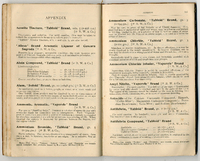
'Tabloid' A Brief Medical Guide (p116,117)
A guide to illnesses common to tropical regions and how to cure them using Burroughs Wellcome & Co.'s products -
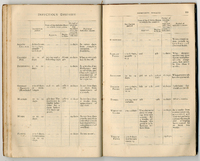
'Tabloid' A Brief Medical Guide (p114,115)
A guide to illnesses common to tropical regions and how to cure them using Burroughs Wellcome & Co.'s products -
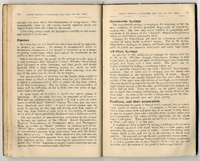
'Tabloid' A Brief Medical Guide (p112,113)
A guide to illnesses common to tropical regions and how to cure them using Burroughs Wellcome & Co.'s products -
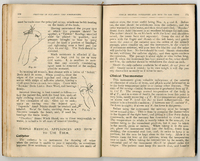
'Tabloid' A Brief Medical Guide (p110,111)
A guide to illnesses common to tropical regions and how to cure them using Burroughs Wellcome & Co.'s products -

'Tabloid' A Brief Medical Guide (p108,109)
A guide to illnesses common to tropical regions and how to cure them using Burroughs Wellcome & Co.'s products -
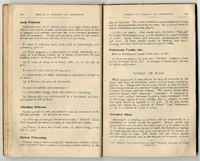
'Tabloid' A Brief Medical Guide (p106,107)
A guide to illnesses common to tropical regions and how to cure them using Burroughs Wellcome & Co.'s products -

'Tabloid' A Brief Medical Guide (p104,105)
A guide to illnesses common to tropical regions and how to cure them using Burroughs Wellcome & Co.'s products -

'Tabloid' A Brief Medical Guide (p102,103)
A guide to illnesses common to tropical regions and how to cure them using Burroughs Wellcome & Co.'s products -

'Tabloid' A Brief Medical Guide (p100,101)
A guide to illnesses common to tropical regions and how to cure them using Burroughs Wellcome & Co.'s products -

'Tabloid' A Brief Medical Guide (p98,99)
A guide to illnesses common to tropical regions and how to cure them using Burroughs Wellcome & Co.'s products -

'Tabloid' A Brief Medical Guide (p96,97)
A guide to illnesses common to tropical regions and how to cure them using Burroughs Wellcome & Co.'s products -

'Tabloid' A Brief Medical Guide (p94,95)
A guide to illnesses common to tropical regions and how to cure them using Burroughs Wellcome & Co.'s products -

'Tabloid' A Brief Medical Guide (p92,93)
A guide to illnesses common to tropical regions and how to cure them using Burroughs Wellcome & Co.'s products -

'Tabloid' A Brief Medical Guide (p90,91)
A guide to illnesses common to tropical regions and how to cure them using Burroughs Wellcome & Co.'s products -

'Tabloid' A Brief Medical Guide (p88,89)
A guide to illnesses common to tropical regions and how to cure them using Burroughs Wellcome & Co.'s products -

'Tabloid' A Brief Medical Guide (p86,87)
A guide to illnesses common to tropical regions and how to cure them using Burroughs Wellcome & Co.'s products -
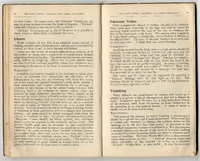
'Tabloid' A Brief Medical Guide (p84,85)
A guide to illnesses common to tropical regions and how to cure them using Burroughs Wellcome & Co.'s products -

'Tabloid' A Brief Medical Guide (p82,83)
A guide to illnesses common to tropical regions and how to cure them using Burroughs Wellcome & Co.'s products -
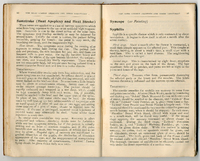
'Tabloid' A Brief Medical Guide (p80,81)
A guide to illnesses common to tropical regions and how to cure them using Burroughs Wellcome & Co.'s products


